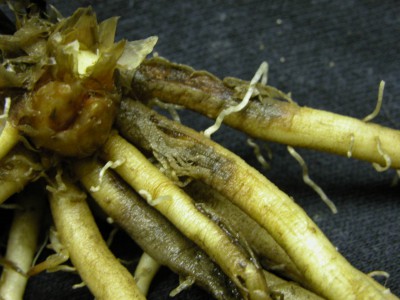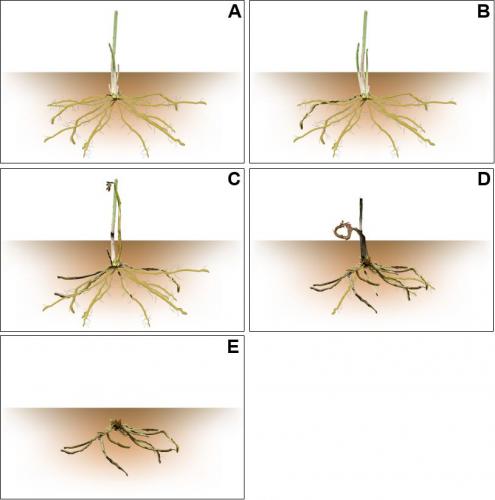May 30, 2018Know symptoms of phytophthora on asparagus crowns, fern
Years ago, a new system of asparagus production was proposed to ensure that newly established fields remain viable and productive and to increase the return on the initial investment. This new system relies on clean and healthy crowns. While research and experience have shown that fumigation with metam potassium (e.g., Sectagon) can reduce levels of soilborne pathogens, it will not completely eliminate them. Additional measures for crown disease management are also needed to compliment fumigation, round out our toolbox and help lengthen field productivity. Recent research efforts have tested applications of soil-applied fungicides to asparagus seedlings in the seedbed nursery. However, fungicides that would be effective against phytophthora on asparagus are not currently labeled for use in an asparagus seedbed nursery. Also, there are no fungicides registered for use as asparagus crown soaks that work against phytophthora. The main product that is currently used, Cannonball WP, has activity against fusarium but not phytophthora.
Even with the best fumigation application, pathogen levels may be reduced but not eradicated, resulting in some diseased crowns. Whenever possible, inspect the crowns prior to planting in the production field to determine whether phytophthora is a problem. Symptoms of phytophthora on the dormant asparagus crowns are distinctive as the roots typically appear water-soaked and gray (Photo 1). There is not another disease that occurs on asparagus crowns that looks similar. The hardest part of inspecting crowns and is that soil from the field makes it hard to see whether the roots are white and healthy or showing that gray discoloration that indicates phytophthora may be a problem. Any crowns with the grayish discoloration should not be planted as there is no cure for crowns infected by phytophthora.
Figure 2. Progression of phytophthora disease (darkened areas) on an asparagus plant. (A) The crown was originally infected when it was planted and the infection is limited. (B) The infection has expanded and now includes a larger portion of the roots. (C) The infection has expanded so that aboveground symptoms are visible, including a shriveled spear whose growth can no longer be sustained by the infected crown. (D) As the infection continues, the ability to support spear and fern growth becomes more difficult. The buds become infected and cannot produce spear/fern growth. (E) The crown’s infection is advanced leading to a “blind” crown that does not grow.
Photo at top: Photo 1. Grayish, shriveled, water-soaked, infected storage roots of an asparagus crown infected with phytophthora.
– Mary Hausbeck, Michigan State University Extension, Department of Plant, Soil and Microbial Sciences, and Ben Werling, MSU Extension


















